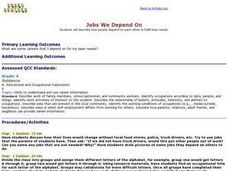Curated OER
Soild Waste and Recycling
In this unit of lessons, students examine solid waste and recycling. They discover the concept of decomposition. They also observe the decomposition process and make observatins.
Curated OER
Pond Exploration
Students take a hands-on approach to explore the world beneath the water in this activity. They examine the creatures they catch to study about the adaptations these animals have that allow them to survive in this harsh environment. They...
Curated OER
Habitat Is Home
Students are introduced to the concept and components of a habitat. They discuss the key components of a habitat and describe how certain factors can cause disturbances in a habitat and change its population. Activities are leveled for...
Curated OER
Insect Safari
Third graders name and identify three body parts of an insect, identify the characteristics that insects have six legs and one pair of antennae and categorize insects as to whether they are helpful or harmful.
Curated OER
Habitat Lap Sit
Fourth graders physically form a circle that shows the interconnectedness of the components of a habitat. They form circles and role play the parts of habitats.
Curated OER
Yeast Bread - Pretzel Lab
Students work with yeast in preparing soft pretzels. They identify the characteristics and ingredients used in yeast breads from quick breads, and how to prepare them in a variety of recipes. They need to set their table, eat and...
Curated OER
Pie Crust Experiment
This experiment can be used as a pre-assessment to see what experience and knowledge the students have in preparing pies. They identify the difference in taste, flavor, texture and appearance as they substitute different ingredients for...
Curated OER
Jobs We Depend On
Fourth graders investigate how people depend on each other to fulfill their needs.
Curated OER
Observing Plants
Students identify how plants affect the survival of a caterpillar and what plants need to survive. They plant three bean seeds in the three containers, placing two containers at a sunny window and the third one in a dark closet and label...
Curated OER
The Everyday Lives of Arkansas Slaves
Eighth graders become aware of the various aspects of daily activities in the lives of Arkansas slaves. They write answers to questions and prepare a transparency to share with the class that illustrates the topic being researched.
Curated OER
A Brief History of Los Angeles
Students study the diverse cultures that make up the population of Los Angeles.
Curated OER
It's For the Birds
Fifth graders examine how anatomical adaptations make it possible for a bird to survive in various habitats. They discuss and list birds and their unique characteristics, and create an imaginary bird, illustrating the environmental...
Curated OER
Gluten and Balloons What Do They Have In Common?
Students examine the purpose of gluten in bread making and what type of flour is needed to make bread. They compare the properties of a balloon to bread dough to explain yeast fermentation. They make bread.
Curated OER
Creature Creation
Second graders listen to a read aloud of a fictional story about a frog. They compare the characteristics of the main character with a real frog. They work with two partners to create a creature; one student draw the head, one the body,...
Curated OER
Pottery Analysis
Students study how archaeologists analyze artifacts to answer questions about past cultures. They explain why pottery is important to archaeologists and how they use classification to answer their research questions.
Curated OER
Geo Jammin' By DeSign - Day 7, Lesson 37: Summarizing for the Summative
Students listen for specific information during summary presentations. They practice giving feedback on given topic according to a set of standards. The speaker reports to the rest of class from a report and listeners determine if...
Curated OER
Nutritionist for Hire
Tenth graders role play that they are nutritionists devising a healthy dietary plan that focuses on the client's needs.
Curated OER
Weather... Or Not
Young scholars observe and discuss the local weather patterns, researching cloud types and weather patterns for cities on the same latitude on the Internet. They record the data for 6-8 weeks on a graph, and make weather predictions for...
Curated OER
Hajigul's Story: A Creative Drama
Learners listen to stories about and research the life of an Uighur child from China. They investigate their own cultural heritage and design a mural.
Curated OER
We Need Cash
Young scholars describe charitable, religious, and civic services in their community, and argue for the value of these services. They write a one-page explanation as to why this service is important to the community and why it deserves...
Curated OER
Graphing a Healthy Lifestyle
Fifth graders record the amount of time they spend sleeping, attending school, watching T.V., exercising and doing homework. At the end of the week they graph all of their information and discuss how sleep impacts their learning....
Curated OER
Small Intestine, Pancreas, Liver, and Gall Bladder
In this small intestine, pancreas, liver, and gall bladder worksheet, students fill in the blanks with information about these structures of digestion. Students research information about organ of the digestive system given.
Curated OER
Plant Growth
First graders investigate how seeds are moved and how plants grow. In this plant growth lesson, 1st graders listen to stories, play a game, and view a PowerPoint about plant growth. Students examine various seeds and recognize how...
ClassFlow
Class Flow: Food Groups
[Free Registration/Login Required] This flipchart contains a basic lesson introducing food groups along with healthy choices having to due with nutrition.
Other popular searches
- Five Basic Food Groups
- Four Basic Food Groups
- 4 Basic Food Groups
- 5 Basic Food Groups
- Basic Food Groups Free
- 3 Basic Food Groups
- Basic Food Groups Worksheets

























